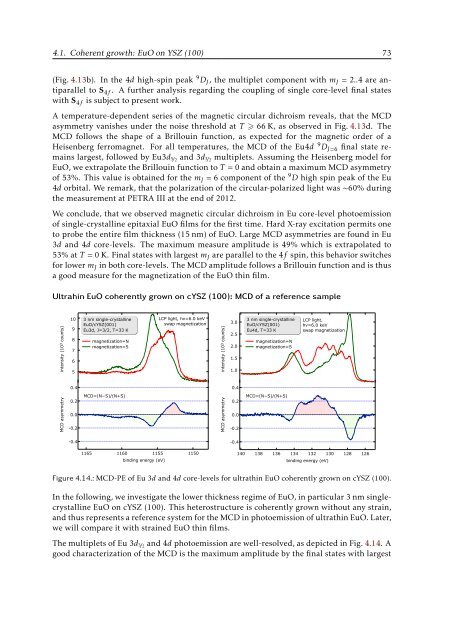Text anzeigen (PDF) - Universität Duisburg-Essen
Text anzeigen (PDF) - Universität Duisburg-Essen
Text anzeigen (PDF) - Universität Duisburg-Essen
You also want an ePaper? Increase the reach of your titles
YUMPU automatically turns print PDFs into web optimized ePapers that Google loves.
4.1. Coherent growth: EuO on YSZ (100) 73<br />
(Fig. 4.13b). In the 4d high-spin peak 9 D J , the multiplet component with m J = 2..4 are antiparallel<br />
to S 4f . A further analysis regarding the coupling of single core-level final states<br />
with S 4f is subject to present work.<br />
A temperature-dependent series of the magnetic circular dichroism reveals, that the MCD<br />
asymmetry vanishes under the noise threshold at T 66 K, as observed in Fig. 4.13d. The<br />
MCD follows the shape of a Brillouin function, as expected for the magnetic order of a<br />
Heisenberg ferromagnet. For all temperatures, the MCD of the Eu4d 9 D J=6 final state remains<br />
largest, followed by Eu3d5/2 and 3d3/2 multiplets. Assuming the Heisenberg model for<br />
EuO, we extrapolate the Brillouin function to T = 0 and obtain a maximum MCD asymmetry<br />
of 53%. This value is obtained for the m J = 6 component of the 9 D high spin peak of the Eu<br />
4d orbital. We remark, that the polarization of the circular-polarized light was ∼60% during<br />
the measurement at PETRA III at the end of 2012.<br />
We conclude, that we observed magnetic circular dichroism in Eu core-level photoemission<br />
of single-crystalline epitaxial EuO films for the first time. Hard X-ray excitation permits one<br />
to probe the entire film thickness (15 nm) of EuO. Large MCD asymmetries are found in Eu<br />
3d and 4d core-levels. The maximum measure amplitude is 49% which is extrapolated to<br />
53% at T = 0 K. Final states with largest m J are parallel to the 4f spin, this behavior switches<br />
for lower m J in both core-levels. The MCD amplitude follows a Brillouin function and is thus<br />
a good measure for the magnetization of the EuO thin film.<br />
Ultrahin EuO coherently grown on cYSZ (100): MCD of a reference sample<br />
MCD asymmetry intensity (10 3 counts)<br />
10<br />
9<br />
8<br />
7<br />
6<br />
5<br />
0.4<br />
0.2<br />
0.0<br />
-0.2<br />
3 nm single-crystalline<br />
EuO/cYSZ(001)<br />
Eu3d, J=3/2, T=33 K<br />
magnetization=N<br />
magnetization=S<br />
MCD=(N−S)/(N+S)<br />
LCP light, hv=6.0 keV<br />
swap magnetization<br />
MCD asymmetry intensity (10 3 counts)<br />
3.0<br />
2.5<br />
2.0<br />
1.5<br />
1.0<br />
0.4<br />
0.2<br />
0.0<br />
-0.2<br />
3 nm single-crystalline<br />
EuO/cYSZ(001)<br />
Eu4d, T=33 K<br />
magnetization=N<br />
magnetization=S<br />
MCD=(N−S)/(N+S)<br />
LCP light,<br />
hv=6.0 keV<br />
swap magnetization<br />
-0.4<br />
-0.4<br />
1165 1160 1155 1150<br />
binding energy (eV)<br />
140 138 136 134 132 130 128 126<br />
binding energy (eV)<br />
Figure 4.14.: MCD-PE of Eu 3d and 4d core-levels for ultrathin EuO coherently grown on cYSZ (100).<br />
In the following, we investigate the lower thickness regime of EuO, in particular 3 nm singlecrystalline<br />
EuO on cYSZ (100). This heterostructure is coherently grown without any strain,<br />
and thus represents a reference system for the MCD in photoemission of ultrathin EuO. Later,<br />
we will compare it with strained EuO thin films.<br />
The multiplets of Eu 3d3/2 and 4d photoemission are well-resolved, as depicted in Fig. 4.14. A<br />
good characterization of the MCD is the maximum amplitude by the final states with largest
















